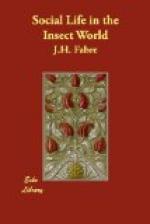What else do we notice? The blind, pale larva is far more voluminous than in the mature state; it is swollen with liquid as though it had dropsy. Taken in the fingers, a limpid serum oozes from the hinder part of the body, which moistens the whole surface. Is this fluid, evacuated by the intestine, a product of urinary secretion—simply the contents of a stomach nourished entirely upon sap? I will not attempt to decide, but for convenience will content myself with calling it urine.
Well, this fountain of urine is the key to the enigma. As it digs and advances the larva waters the powdery debris and converts it into a paste, which is immediately applied to the walls by the pressure of the abdomen. Aridity is followed by plasticity. The mud thus obtained penetrates the interstices of the rough soil; the more liquid portion enters the substance of the soil by infiltration; the remainder becomes tightly packed and fills up the inequalities of the walls. Thus the insect obtains an empty tunnel, with no loose waste, as all the loosened soil is utilised on the spot, converted into a mortar which is more compact and homogeneous than the soil through which the shaft is driven.
Thus the larva works in the midst of a coating of mud, which is the cause of its dirtiness, so astonishing when we see it issue from an excessively dry soil. The perfect insect, although henceforth liberated from the work of a sapper and miner, does not entirely abandon the use of urine as a weapon, employing it as a means of defence. Too closely observed it throws a jet of liquid upon the importunate enemy and flies away. In both its forms the Cigale, in spite of its dry temperament, is a famous irrigator.
Dropsical as it is, the larva cannot contain sufficient liquid to moisten and convert into easily compressible mud the long column of earth which must be removed from the burrow. The reservoir becomes exhausted, and the provision must be renewed. Where, and how? I think I can answer the question.
The few burrows uncovered along their entirety, with the meticulous care such a task demands, have revealed at the bottom, encrusted in the wall of the terminal chamber, a living root, sometimes of the thickness of a pencil, sometimes no bigger than a straw. The visible portion of this root is only a fraction of an inch in length; the rest is hidden by the surrounding earth. Is the presence of this source of sap fortuitous? Or is it the result of deliberate choice on the part of the larva? I incline towards the second alternative, so repeatedly was the presence of a root verified, at least when my search was skilfully conducted.




